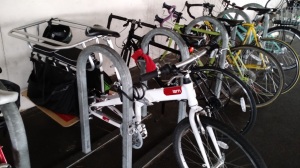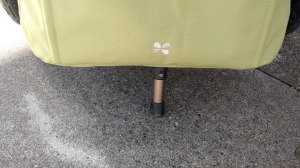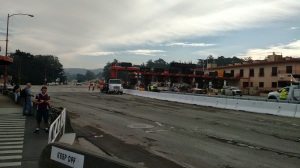Hey, it’s another year gone by. We still pick up our Christmas tree by bicycle. This year’s was a bit over six feet tall (~180cm for the rest of the world), reflecting one of the biggest changes since I started writing back when the kids were little: they are not small anymore. When they first started expressing opinions about trees, it was no big deal that each wanted a tree “taller than I am.” Now that our son is 14 and our daughter is 10, it’s become evident that this idea, which seemed pretty harmless when they were in preschool, was not the most cost-effective long-term plan. I’ve still just a little bit taller than the teen, but it won’t be long before he’s looking down on me—physically, that is, not just figuratively.
After all this time I don’t have anything like the patience to do more than hit some highlights of the last few years, but in no particular order:
- Our kids both transitioned to new schools: our son started high school this year, and our daughter moved to an elementary and middle school combined program. They’re both really happy. Our daughter’s school is in Chinatown and nowhere near where we live or I work, but happily pretty close to Matt’s office and also extremely transit-accessible. Unfortunately the bike infrastructure around there is dreadful, which leads to…
- We got a new cargo bike, because the Bullitt has insufficient torque, insufficient battery power, and way too wide a profile to haul a bigger kid up and over Pac Heights and back home again. So Matt’s now riding a Tern GSD for that commute. So far so good. Obviously I haven’t reviewed any cargo bikes for a while, but I guess if you were desperate to know what bike I would buy in a market that’s completely changed, now you know. (We are well out of the years when it makes sense to haul kids by front-loader. Try a Riese & Mueller maybe?)
- Work has been the biggest contributor to this blog’s increasingly infrequent updates: a few years ago the school voted to change its curriculum from a 4-year program with summer breaks to a 3-year program that is in session year-round. None of the other schools at the university has done this so it’s been a lot. I don’t know what I was thinking, but somehow in all the planning I didn’t consider that this meant I would be teaching in two completely different programs for three straight years, which is both confusing and overwhelming. We’re in the middle of that transition, so check back in June 2021, I guess.
- Other than that work is great. After my promotion last year I started getting a lot more invitations to teach overseas. So I spent a month in Japan in 2017 and again in 2019, and Japanese bicycle culture is awesome despite having very little of what I think of as good infrastructure, such as protected bike lanes (or really any bike lanes). Everyone bikes on the sidewalk and so did I. Everyone bikes everywhere, in fact, to the point that the campus bicycle parking is about the same size as the car parking—which obviously means a lot more bikes, given how much smaller they are. Drivers are very, very courteous so I got used to cruising around safely late at night (and then got rapidly un-used to that lovely feeling of safety on my return). I also got used to riding without a helmet, which it turns out really is much nicer than riding with one. Not only do people in Japan skip helmets, they don’t have seats for babies. They just carry them around in slings and backpacks and hop on and off their bikes. And then once kids start toddling around they ride in seats that are basically recliners with rain covers. By 2019 the majority of bicycles I saw were assisted, although not my junky university loaner, which is fine. Anyway: same planet, different worlds.
- Other professional trips included: (1) a trip to Seoul, where people also ride bicycles mostly on the sidewalk, also without helmets, which increasingly seem like a “colony where the British dumped a lot of prisoners” affectation by world standards. However unlike Japan, where drivers are cautious and street parking is illegal, drivers in Seoul are terrifying and like Americans, unapologetically park on sidewalks. Seeing 7-Elevens sell individual glasses of wine, though—and they all did—was memorable. (2) I also visited Switzerland, where the thing about the trains running on time is absolutely true. Geneva has amazing public transit and is crammed with bicycles—like in Japan, these are mostly assisted, and not the little boost that Japanese bikes offer, but serious assists for serious hills. Even better than that was that in the middle of the city there was very little car traffic. My hotel was across the street from the main train station and a huge intersection and at 7:30am when I woke up I’d hear birds chirping over the faint whoosh of electric streetcars because it was so quiet. It was like that all day. Experiences like that were why I chose “hum of the city” as a name so I adored it.
- Lots of other stuff has happened but most of it was at best less than awesome and at worst terrible, so I will skip it.
One more thing: a question that comes up repeatedly from families with young kids is whether the kids will keep riding once they’re not cargo anymore. I have only two kids, so I can’t speak universally or anything, but our experience has been sort of mixed. Part of being a teenager is forging a new identity, and that means discarding things your parents like to do because that’s what you’re trying to change. Our son, now 14, gave up commuting to school on his own bike part of the way through 6th grade and hasn’t returned to regular riding. On the other hand, his rebellion against the hopelessly uncool bicycle is… riding transit and walking. And over time I’ve come to see the appeal for him: he can talk to friends (most of whom don’t have bicycles) and play games on his phone, and no one is bugging him to do anything in particular. From his perspective it has a lot going for it; it’s really just being chauffeured or wandering around without any sense of urgency or direct parental attention. So a couple of years ago we sent him to SF Rec and Parks Transit Camp and rolled with it (no pun intended). By contrast our daughter, now 10, is still essentially cargo, but nonetheless prefers riding a bicycle for now.
But there are, it turns out, some unique advantages to having an older kid who’s competent with public transportation and has given up riding a bicycle solo. The main one is that he’s capable of picking up his sister when we’re busy, and that is something that he could not do on a bicycle. That’s something that he started doing occasionally at 12 and it became a regular expectation at age 13. I only really thought about this recently when another parent—outside the city—mentioned that when their oldest reached 16 they’d finally be able to ferry around their siblings. As an official public health killjoy I would never, ever, ever allow a 16 year old child in my care to drive (or even ride as a passenger with a teen driver), because teenagers are phenomenally, hideously, appallingly bad drivers, and training and practice do not improve these outcomes at all. In fact a colleague of mine did a large study for Congress a few years ago showing that teen driver education increased collisions because it made it possible young people to drive earlier. Teen drivers can’t accurately assess risk, are easily distracted by passengers and music, text constantly even when they swear they don’t, are responsible for at least 80% of the car crashes in which they’re involved, are more likely than matched controls to use alcohol and other drugs, and have higher rates of sexually transmitted infections. The safest age to start driving is 25 (this is also a reasonable minimum age of legal access for alcohol, tobacco, and firearms, for similar reasons). The thought of actually encouraging a 16 year old to get a license so that they could drive around their siblings, who are like the biggest possible distraction because most siblings argue all the time, shocked me speechless. However. Once I got over that I realized that a kid who can confidently ride transit is far better, and so that’s what I say now: my oldest started getting his sister places a full four years earlier than any kid the same age who drives, and public transportation is one of the world’s safest ways to travel.
Maybe our son will return to riding a bicycle in college or beyond and maybe not. He hasn’t shown any interest in driving, despite the fact that I hate the idea of him doing it, which seems like it should make it more appealing, but there you go.
Back to the tree though: as the video shows, carrying big things by bicycle is also the best way to escape murderous auto traffic. Happy holidays, and may 2020 be kinder to all of us.






































![Don't even start with that "you can't carry [X] on a bike" nonsense.](https://humofthecity.files.wordpress.com/2015/03/driveway.jpg?w=300&h=169)





